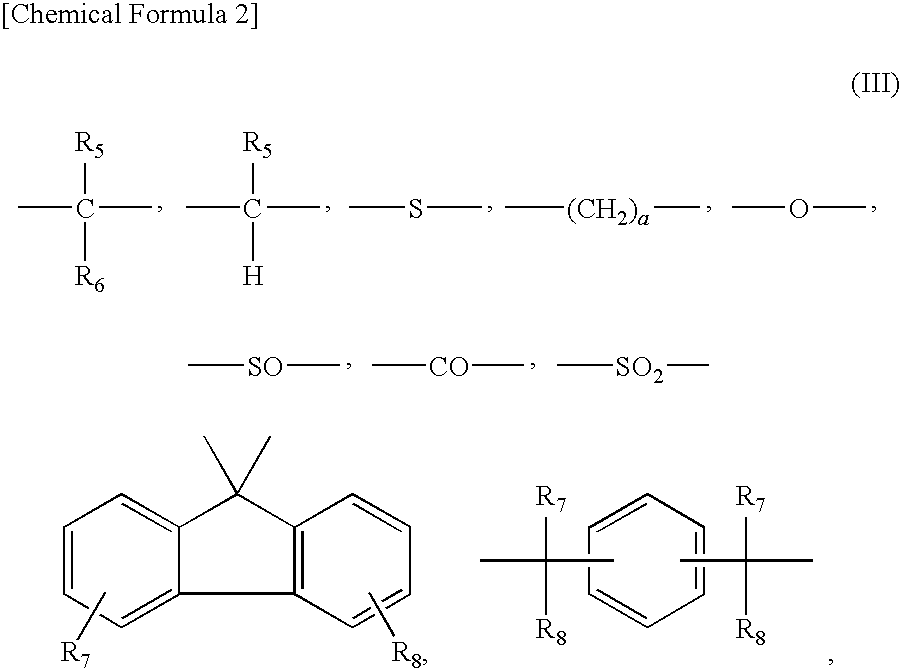Polycarbonate Resin and Optical Material Comprising the Same
a technology of polycarbonate resin and optical material, applied in the field of polycarbonate resin, can solve the problems of insufficient pc performance, insufficient performance of optical disk substrate, and insufficient performance of pc, and achieve the effects of low change rate of hygroscopic expansion coefficient, novel properties, and excellent properties
- Summary
- Abstract
- Description
- Claims
- Application Information
AI Technical Summary
Benefits of technology
Problems solved by technology
Method used
Image
Examples
example 1
[0066]20 g of hydrosulfite and 7.00 Kg of 2,2-bis(4-hydroxyphenyl)propane (hereinafter, “BPA”) were added and dissolved into 52 L of 7.9% (w / w) aqueous solution of sodium hydroxide. Then, 32 L of methylene chloride was added to the aqueous solution and 3.67 Kg of phosgene was blown into the solution at a rate of 0.12 Kg / min, while stirring the solution and keeping the temperature of the solution to 15° C.
[0067]A solution obtained by dissolving 620 g of dodecyl-4-hydroxybenzoate, manufactured by API Corporation, trade name; “POB-C12” (hereinafter, “POB-C12”), as a chain terminator into 3 L of warmed methylene chloride at 35° C. was added into the above-mentioned solution after blowing phosgene. Then, the mixed solution was stirred intensely for 10 minutes. Further, 12 ml of triethylamine was added thereto and the mixed solution was stirred for about an hour for polymerization.
[0068]After adding 10 L of methylene chloride and stirring for 5 minutes, the polymerization solution was sep...
example 2
[0079]Experiment was conducted in the same manner as in Example 1 except that 790 g of stearyl-4-hydroxybenzoate, manufactured by API Corporation, trade name; “POB-C18” (hereinafter, “POB-C18”) was used in place of 579 g of the chain terminator “POB-C12”.
[0080]The intrinsic viscosity of the obtained polycarbonate resin was 0.35 dl / g. According to the analysis by means of infrared absorption spectrometry, it was confirmed that the polymer thus obtained had a polycarbonate polymer structure same as that of Example 1 except for its terminal structure. The evaluation results are shown in Table 1 in the same manner as Example 1.
[0081]According to Table 1, it was shown that the polycarbonate resins of Example 1 and Example 2 had the rate of change of hygroscopic-expansion coefficient of not higher than 3.5 ppm / % RH at a temperature of 25° C. and relative humidity of 80% RH-45% RH, which indicates that they were reduced in the rate of change of hygroscopic-expansion coefficient with changi...
PUM
| Property | Measurement | Unit |
|---|---|---|
| pit length | aaaaa | aaaaa |
| pit length | aaaaa | aaaaa |
| pit length | aaaaa | aaaaa |
Abstract
Description
Claims
Application Information
 Login to View More
Login to View More - R&D
- Intellectual Property
- Life Sciences
- Materials
- Tech Scout
- Unparalleled Data Quality
- Higher Quality Content
- 60% Fewer Hallucinations
Browse by: Latest US Patents, China's latest patents, Technical Efficacy Thesaurus, Application Domain, Technology Topic, Popular Technical Reports.
© 2025 PatSnap. All rights reserved.Legal|Privacy policy|Modern Slavery Act Transparency Statement|Sitemap|About US| Contact US: help@patsnap.com



